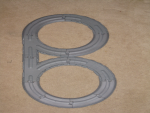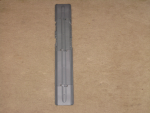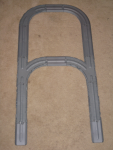
CISRA Puzzle Competition 2012 - Solutions
5B. Upper Class Rail
The train track pieces need to be joined together, but how? Making letters might be a natural guess. "Upper Class" in the title is a clue that upper case letters should be made. Another useful insight is that some "end" pieces are present, which are used to indicate endpoints in the letters rather than just leaving disconnected track.
One general solving technique that works particularly well on this puzzle reliably is to work backwards - think like a puzzle creator rather than a puzzle solver. That is, work out which pieces you would need to use for each letter if you were making a puzzle about building letters out of these train track pieces. It so happens to be easier to compare alternative ways of constructing a letter than alternative letters you can construct from the track. Using that technique, here's a decision tree for letters based on the track pieces that are used in the puzzle, using the most compelling data first.
- 0 Endpoints: B, D, O. B is unique for having forks, while D can be distinguished from O by having some straight pieces.
- 1 Endpoint: P.
- 2 Endpoints: A, C, I, J, L, M, N, Q, S, U, V, W, Z. Of these, A and Q have forks. Q has no straight pieces, or at least fewer than A. The rest can be split on total turning angle:
- 0°: I
- 90°: L, V. V would have a symmetric set of straight pieces, though L might too.
- 180°: C, U, J. U would have the most straight sections, J less and C none.
- 270°: N, W, C, Z. C would have few or no straight pieces. N and Z would need two 45° bends while W would not. N and Z are unavoidably ambiguous as one is basically just the other rotated - the angles are a little different but with only 45° of precision in the rotation there's no way to bring this out.
- 360°: M, S
- 3 Endpoints: E, F, G, T, Y. All of these have one fork. By total turning angle (not counting the bend from the fork):
- 0°: T (maybe Y, but not the best upper case Y)
- 45°: Y
- 90°: F (again maybe Y with two 45° bends, but it's not very good)
- 180°: E
- 270°: G
- 4 Endpoints: H, K, X. K would have 45° bends to make the diagonal parts. (X is difficult given that no crossing piece is shown in the puzzle.)
A note on "R": There are many ways to make "R", and none of them are ideal. For that reason, R was avoided entirely (and also left out of the tree above).
This tree is enough to identify the following message:












NSEW EDGE BITS
(Noting that the N/Z ambiguity is resolved only with context.) But what does it mean?
The key is the framing of the photos. Each photo has exactly one piece (bit) touching each of the four edges of the frame. "NSEW" corresponds to the four compass directions North, South, East, and West, giving an ordering. The trick is to see that the puzzle recurses. Four letters can be formed using the twelve pieces touching each edge of the photos. The available pieces are:
EEEFLLLLSCCC EEEEFFLLLLSS EEFFLLLLSSCC EELLCCBBSSSS
Using the following notation:
- L: Long straight
- S: Short straight
- C: Corner (90°)
- B: Bend (45°)
- F: Fork (there are two types of fork, but the difference isn't helpful)
- E: End
Looking these up in the tree above gives the following constructions:




GHAN
(Again, resolving the N/Z ambiguity through context.)
The Ghan is a railway line crossing the Australian desert, and containing some very upper class accomodations. The solution to this puzzle is GHAN. We also accepted THE GHAN.